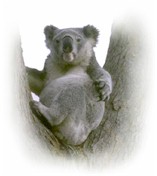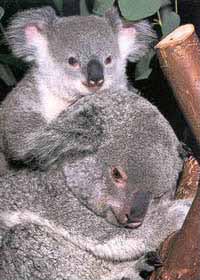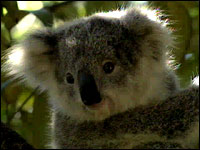Koalas
First described in 1908 by E. Home.
- Latin name:
- Phascolarctos cinereus
(Greek: phaskolos means pouch; arktos means bear. Latin: cinereus means ash-colored.)
Koalas are marsupials, females having a pouch in which their young first develop. Their pouch faces the rear and has a drawstringlike muscle that the mother can tighten. They are the sole member of the family Phascolarctidae.
- Taxonomy:
- Kingdom: Animal
Phylum: Vertibrata
Class: Mammalia
Sub-Class: Marsupialia
Order: Diprotodontia
Sub-Order: Vombatiformes
Infra order: Phascolarctomorphia
Family: Phascolarctidae
Genus: Phascolarctos Cinereus
- Subspecies:
- There are three subspeies:
P.c. victor (Victoria)
P.c. cinereus (New South Wales)
P.c. adustus (Queensland).
- Size:
- Size is larger in the southern regions. Head-body length in the south average 30.7 in./78 cm for males and 28 in./72 cm for females.
- Weight:
- Average 26 lbs/11.8 kg for southern males and 17.4 lbs/7.9 kg for southern females. In the north, males average 14.3 lbs/6.5 kg; females 11.2 lbs/5.1 kg. At birth young weighs only 0.5 gm. (This is no typo; it is amazing how small they are at birth, about the size of a bee.)
- Fur:
- The fur of the koala in southern region is thick and woolly and is thicker and longer on the back than on the belly. Koalas in northern region have a short coat; this gives them a naked appearnace. The color and pattern of the coat varies considerably between individuals and with age.
- Coat:
- Thickest of the marsupials. Gray to tawny: white on the chin, chest, and forelimbs. Rump consists of tougher connective tissue dappled with white patches. Fluffy ears with longer white hairs. Coat is shorter and lighter in color toward northern regions.
- Gestation period:
- 34-36 days.
- Life span:
- Their life span today varies considerably due to stress factors, probably averaging 13-18 years.
- Principal predator:
- Humans
There were once several different kinds of koala - all but one of which had died out. The earliest known member of the koala family was a browser, which lived 15 millions years ago. Evidence of a 'giant' koala, twice the size of its modern descendant, exists in fossils dating back more than 40,000 years. The sequence of koalas in the fossil record:
A Brief History
From: Koala Handbook by Simon Hunter
- 15 million years ago: Perikoala palankarinnica
- 10 million years ago: Litokoala kutjamarpensis
- 5 million years ago: Koobor notabilis & Koobor jimbarratti
- 0 million years ago: Phascolarctos cinereus & Phascolarctos stirtoni
- 1798, January 26: The 1st record of a koala being seen by an European, named John Price.
- 1803, August 21: The first detailed account of a koala was published in Sydney Gazette.
- 1816: the French naturalist de Blainwill gave the koala its scientific name, Phascolarctos, from the Greek words for 'leather pouch' and 'bear'. Later, the German naturalist Goldfuss gave it the specific name cinereus, meaning 'ash-coloured', after the color of the original specimen.
History of the name: "koala"
In their history of the koala, Tom Iredale and Gilbert Whitley (1934) suggest that the common name "koala" was derived from an Aboriginal dialect of eastern New South Wales. Ronald Strahan (1978) lists cullewine, koolewong, colo, colah, koolah, kaola and koala as published dialectal variations of the name in that region, "complicated by problems of transliteration and printers" errors.The early settlers referred to koalas as sloths, monkeys, bears, and even monkey bears, adopting the unfortunate practice of transposing the names of animals which were already familiar to Europeans to Australian lookalikes. The virtual absence of a tail, together with their stocky build and their relatively long legs, gives the koalas a bear-like appearance, and undoubtedly led to their being referred to as, "koala bears", or, "native bears".
From: The Koala: A Natural History by Anthony Lee & Roger Martin
Birth and Pouch Life
From: The Koala: A Natural History by Anthony Lee & Roger Martin
- Usually, koalas produce only a single young, rarely twins are born.
- At birth, the young is about 19 mm in length and weighs about 0.5 g.
- At 7 weeks, the young has a head length of about 26 mm. The head is large in proportion to the rest of the body.
- By 13 weeks, the young has attained a body weight of about 50 g and a head length of 50 mm.
- At about 22 weeks of age, the eyes open and the young begins to poke its head out of the pouch for the first time.
- By 24 weeks of age, the cub is fully furred and the first teeth erupt.
- At 30 weeks, the cub weighs about 0.5 kg and has a head length of 70 mm. It now spends most of the time out of the pouch clinging to the mother's belly.
- Some 6 weeks later, the cub weighs 1 kg and no longer enters the pouch. It spends much of the time sitting on the mother's back, but returns to the mother's belly in cold, wet weather and to sleep.
- At 37 weeks, the cub moves from contact with the mother; the excursions were brief and quickly terminated if the mother moved.
- At 44 weeks, the cub still ventures less than a meter from the mother.
- By 48 weeks, the cub is more adventurous and no longer squeaked when the mother was removed. At this age, mother and cub are often seen sleeping back to back.
- The cub remains with the mother until about 12 months of age when it weighs a little over 2 kg.
Koala Physiology
From: Koalas - Australia's Ancient Ones by Ken Phillips
- Unlike bears or seals, koalas do not rely on a layer of fat below the skin as a form of insulation.
- Blood flow to extremities in cold weather, as in humans, can be reduced, resulting in the conservation of heat.
- Shivering has also been observed in cold climes as a means of creating heat through rapid contractions of certain muscles. This seems to occur when outdoor temperatures drop below 10 degrees Centigrade.
- When temperatures exceed 25-30 degrees Centigrade, koalas use evaporative cooling in their airways to regulate body temperature by increasing respiration rates. They can simultaneously reduce water loss by decreasing the amount of water in their urine.
More Koala Facts

From: Koalas - Australia's Ancient Ones by Ken Phillips
- Koalas don't live in families, but are solitary animals.
- Koalas sleep as long as 18 hours a day and have a low-energy diet of eucalyptus leaves.
- Koalas are not "drunk" or otherwise intoxicated by their leaves.
- Although koalas obtain most of their water from leaves -- the name koala is thought to mean "no drink" in several native Aboriginal tongues -- they do occasionally drink water at the edges of streams.

HOME
Koala Hotlinks
Lesbian koalas
Koala Contraception



